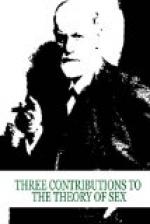The nearer we come to the deeper disturbances of the psychosexual development the more easily we can recognize the evident significance of the incestuous object-selection. As a result of sexual rejection there remains in the unconscious of the psychoneurotic a great part or the whole of the psychosexual activity for object finding. Girls with an excessive need for affection and an equal horror for the real demands of the sexual life experience an uncontrollable temptation on the one hand to realize in life the ideal of the asexual love and on the other hand to conceal their libido under an affection which they may manifest without self reproach; this they do by clinging for life to the infantile attraction for their parents or brothers or sisters which has been repressed in puberty. With the help of the symptoms and other morbid manifestations, psychoanalysis can trace their unconscious thoughts and translate them into the conscious, and thus easily show to such persons that they are in love with their consanguinous relations in the popular meaning of the term. Likewise when a once healthy person falls sick after an unhappy love affair, the mechanism of the disease can distinctly be explained as a return of his libido to the persons preferred in his infancy.
The After Effects of the Infantile Object Selection.—Even those who have happily eluded the incestuous fixation of their libido have not completely escaped its influence. It is a distinct echo of this phase of development that the first serious love of the young man is often for a mature woman and that of the girl for an older man equipped with authority—i.e., for persons who can revive in them the picture of the mother and father. Generally speaking object selection unquestionably takes place by following more freely these prototypes. The man seeks above all the memory picture of his mother as it has dominated him since the beginning of childhood; this is quite consistent with the fact that the mother, if still living, strives against this, her renewal, and meets it with hostility. In view of this significance of the infantile relation to the parents for the later selection of the sexual object, it is easy to understand that every disturbance of this infantile relation brings to a head the most serious results for the sexual life after puberty. Jealousy of the lover, too, never lacks the infantile sources or at least the infantile reinforcement. Quarrels between parents and unhappy marital relations between the same determine the severest predispositions for disturbed sexual development or neurotic diseases in the children.
The infantile desire for the parents is, to be sure, the most important, but not the only trace revived in puberty which points the way to the object selection. Other dispositions of the same origin permit the man, still supported by his infancy, to develop more than one single sexual series and to form different determinations for the object selection.[11]




